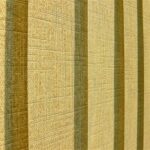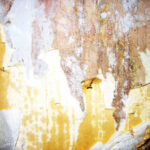What is Lincrusta Wallcovering?
In 1877, Frederick Walton wanted to create a wall covering similar to the expensive plaster wall coverings of the time. Houses built during the Victorian era had walls covered with complex embossed plaster friezes, panels and more.
Lincrusta is made from materials similar to linoleum, and is paintable. It comes in a plethora of designs, friezes, dados, trims, borders and wallpaper designs.
Preparation
First, remove any existing wallpaper. Repair any holes, chips, etc. in the wall. Clean the wall thoroughly, and allow to dry. Measure each wall and allow extra for mistakes, corners, etc.
Decide whether you want just wall covering, or wall covering with a chair rail. Take a piece of the chair rail with you if the product is available locally.
Remove electrical plates, and protect the flooring.
You will need:
• Marker
• Ruler
• Level
• Dense foam pressure roller
• Vinyl to vinyl adhesive
• Vinyl wallpaper liner with adhesive
• Wallpaper knife
• Utility knife
• Oil based primer and two different colors paint- one base, one highlight
• Roller brush with ½ inch nap, paint tray and proper cleaning equipment
• Clay based adhesive
• Smoothing brush
• Acrylic latex caulk and caulk gun
• Chair rail molding
• Bucket
• Sponge
• Warm water
• Wallpaper brushes
• Mineral spirits, cloths, gloves and safety goggles
Installation
Be prepared for at least a three- day process for installation after the wall is prepped. It does take time for the various products used in the process to cure. This absolutely cannot be done in a single day.
Measure from the baseboard to the top length of your panel. If your panel is 36″ high, make the mark at 36″.
Next, mark a level line around the room where the product will be attached at this height.
To ensure that the panels will hang straight down (plumb), mark the panel’s widths on the wall so they will hang evenly. Shift the marks to the left or right as needed to make sure that no panel in the corners will be less than one quarter of its width, so matching will be easier.
Here’s where my old friend cardboard comes in handy. Cut a piece of scrap cardboard the same size as the panels and move it around as needed, marking the walls to ensure proper panel placement.
Now for the vinyl wallpaper liner. Cut the panels so you’ll be installing them horizontally on the wall. Take your time.
Coat the back of each panel with the proper adhesive for your particular type of wall, and fold glue side to glue side like an accordion. This makes handling it easier.
Begin at one side of the wall, and attach using the level mark on the wall. Using a straight edge and utility knife, trim at the corners and at the baseboards. Smooth the liner so there are no air bubbles, and allow to dry at least overnight.
Begin the panel installation at a vertical line, such as a door casing or a corner. Since your starting point might not be plumb, use the measuring tape and level to create a plumb line (a vertical mark) where the side of the panel will land.
Transfer this mark to the panel, making sure the factory edge lands on the wall side and the side being trimmed lands against the starting point.
Holding a straight edge firmly down on the panel, score several times with the utility knife before cutting through. You may need to replace blades during this project.
The next step may seem strange, but it’s all part of the process. Fill the bucket with warm water and wet the backs of two panels. There should be just enough water for dripping if you tipped the panels up. Lay the panels on top of each other, wet sides touching and leave for thirty minutes. This allows the panels to expand slightly before installation and prevents the seams from buckling.
Wring the sponge out and remove the excess water from the panels. Stir the clay adhesive well, and apply to the back of the panel using the wallpaper brush. You’ll need a thin, even coat with a little extra at the edges. Coat and attach one panel at a time.
You can certainly have two more panels soaking up water while you attach the first two. Make a plan so you can have panels ready as you need them.
Lining the factory edge with the plumb line and the top with the level mark, align the cut edge with your starting point and press into place gently. Take your time- do not bend or fold the product. Small cracks, haze lines and “boo-boos” can be hidden with caulk or paint.
Starting at the center and working your way outward, use the roller to remove any air bubbles. Ensure the panel is firmly attached to the wall. Using a clean, damp cloth, wipe the panel down to remove any excess or stray adhesive.
If you’re not going to use the full height of the panel, don’t cut the bottom off right away. Just install the panel and allow the bottom to hang down over the baseboard. Only apply the adhesive to the area you’re attaching to the wall. Once the panel is in place, mark the baseboard height at each side of the panel. Place a piece of MDF board under the panel and over the baseboard to provide a cutting surface for the utility knife. Place a straight edge over your marks, and using the utility knife as before, score and cut.
Install the next panel. Treat the cutting process for corners the same as you did in the beginning and for the baseboard.
I did say it was a long process, didn’t I? But it’s well worth it.
Once you’ve cut a panel for the corner, save the cutoff and take a breather. You’ve earned it.
Turn a corner- measure the width of the cutoff piece. Using the measuring tape and level, make a plumb line adjacent to the corner. Only remove what’s absolutely necessary to position the piece on the plumb line. On the edge going into the corner, trim material off the back (coping) by using a straightedge and a utility knife held at a 45- degree angle to the back. This allows the piece to slide in place and makes a tight fit.
Install the rest of the panels. To accommodate outlets and fixtures, measure from the level and plumb edge of the last panel to the edges of the outlets. Transfer these marks to the back of the next panel and cut as prescribed.
Allow the panels to dry for at least 24 hours. The adhesive needs it, and you need the rest.
Now for the next step. Hey, come back here. You’re not done- yet.
Get the mineral spirits, gloves, cloths and goggles. Carefully and thoroughly clean the panels to de-grease them for the next step. Allow to dry.
Using the caulk gun, apply caulk in thin beads to the corners and at each seam. Shmoosh it in with your finger and wipe the excess off with a clean, damp sponge. Again, allow to dry for 24 hours. I did say it was a long process.
Now for the fun part. Get the primer/sealer and a roller brush with a ½-inch nap. Carefully paint the panels. With a paintbrush, cut in the edges, corners and to smooth the finish. Tape off the wall, baseboard, trim, etc. if needed first. Again, allow the primer to dry for yet another 24 hours.
You’re getting there. I promise.
Paint the panels with the base coat, cutting in and smoothing with a brush as needed. Allow the paint to dry completely.
Now, get the highlight paint. Using a brush, place a little paint on the bristles and blot on a cloth until almost no paint remains. Using a clean cloth in one hand, and the brush in the other, lightly brush on the high relief areas of the panels. Use the clean cloth to clean up any stray marks. You’re not coating the reliefs, just grazing them. Really take your time with this step to get it just the way you want it. Yeah, I know. Another 24 hours.
Yeah! That’s it. Finally!
The last step: measure, cut and install the chair railing. Move the furniture back in place, and show off your work. You deserve a huge pat on the back.
Notes to Consider:
Lincrusta isn’t a cheap product. Expect to pay between $30 to $60 a linear foot for the product itself, not including tools, adhesives, paint, etc. This is one of those projects to save up for-say, an anniversary, for instance.
Wonderful for high traffic areas such as hallways and dining rooms, even the White House has Lincrusta wainscoting.
Source: Mark Powers, “How to Install a Lincrusta Wainscoat,” , This Old House Magazine Website, no date given
Source: Jennifer Stimpson, “How to Install a Lincrusta Wainscoat,” , This Old House Magazine Website, no date given



